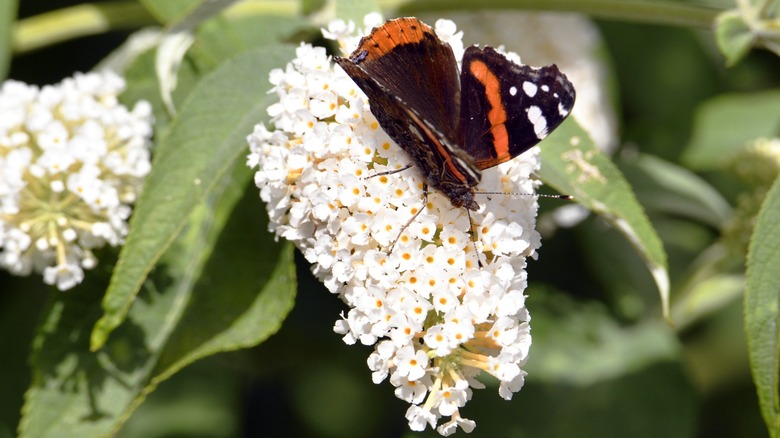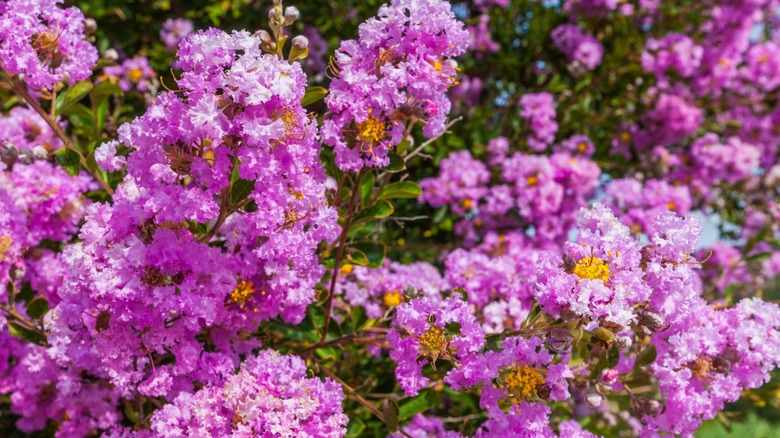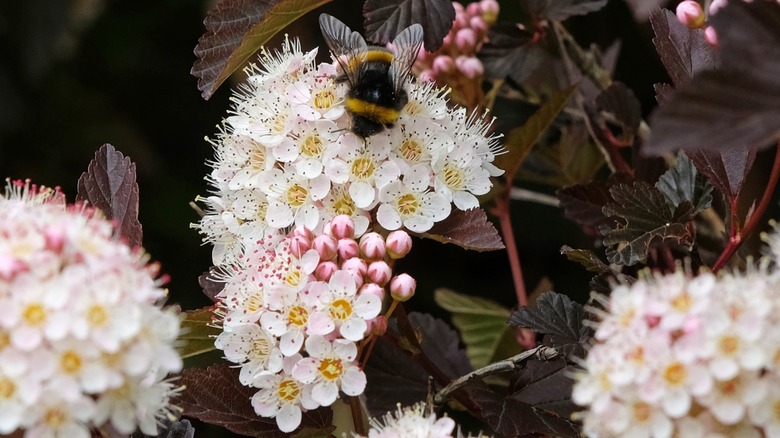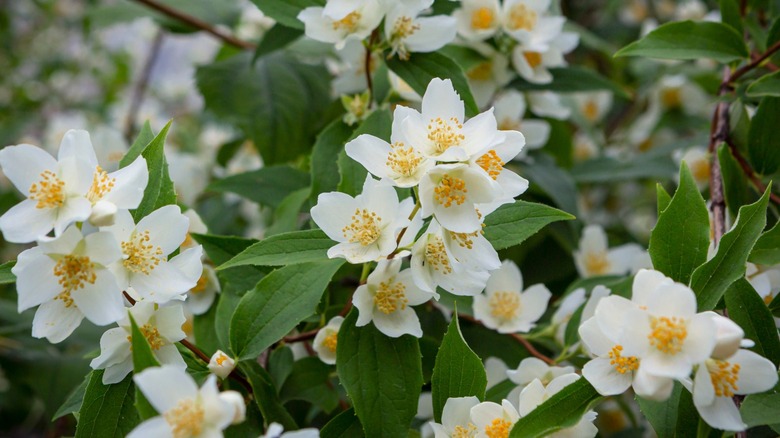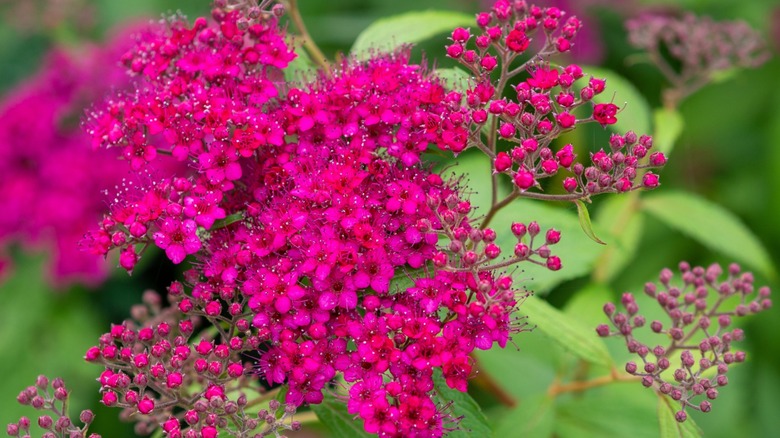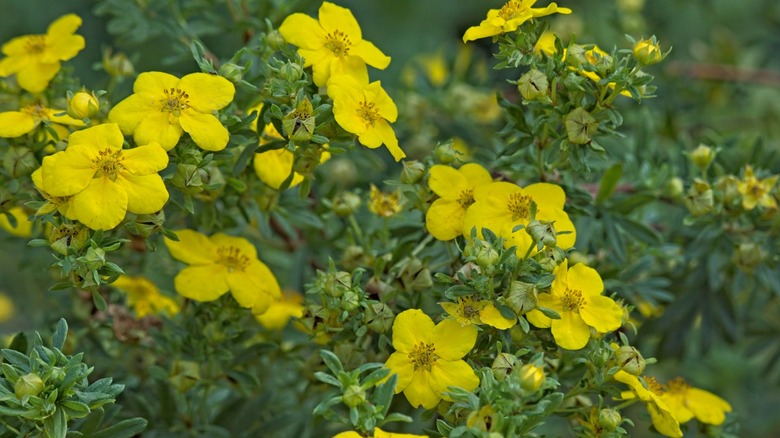The 12 Low-Maintenance Alternatives To Hydrangeas You'll Love
Hydrangeas are some of the loveliest flowers you can add to a garden. For decades, their big, cloud-like blooms have transformed the simplest yards into something truly remarkable. But lately, some gardeners have started ditching hydrangeas. And no, it's not because anyone's suddenly discovered that they're poisonous or invasive plants. It's simply that, for all their beauty, hydrangeas can be surprisingly high-maintenance.
If you live in a zone that runs too hot and dry, hydrangeas might struggle to put on their best show. Even in zones 3 to 9, where they're cleared to thrive, this species tends to be demanding. They're notoriously picky about soil pH — too alkaline or too acidic, and the blooms won't come out in the vibrant color you prefer. They wilt quickly if you don't water them regularly. And if you don't prune them at exactly the right time of year, you could accidentally cut off next season's flowers.
That said, if you're up for the extra work, they're worth the effort. But if you'd rather enjoy that same lush, full look without the constant care, you're not out of options. There are plenty of beautiful flowering shrubs that bring the same color and volume to a garden without the fuss. To help you choose one, we've rounded up some low-maintenance plants that capture everything you love about hydrangeas while giving you more time to enjoy your yard instead of always tending to it.
Summersweet
One thing many gardeners struggle with when growing hydrangeas is finding the right balance of shade. Too much sun and they could wilt, and with too much shade, they might not even bloom. That's why, if you're looking for some beautiful flowers that grow perfectly in the shade, you should go with summersweet (Clethra alnifolia) instead. It produces fragrant bottlebrush blooms that come in clusters of white or pink. Just like hydrangeas, summersweet is hardy in zones 3 through 9 and thrives where the soil is moist and well-drained. It's just not as picky about shade.
Butterfly bush
As the name suggests, butterfly bush (Buddleja davidii) is a magnet for butterflies — and all kinds of pollinators, really. It thrives in full sun and well-drained soil, and once established, it handles heat and drought pretty well. Its long, tapering flower clusters, which range from purple to pink and white, will keep zone 5-9 gardens smelling nice and looking vibrant all summer. One thing you should know, however, is that it can get leggy. And if you live in Oregon, you may need either a sterile cultivar or permit to plant it.
Buttonbush
Instead of the familiar mophead clusters of hydrangeas, buttonbush (Cephalanthus occidentalis) produces perfectly round, white flower balls that look like tiny pincushions. Despite what that might suggest, they're not particularly prickly. On the contrary, they are quite lovely and remarkable at inviting pollinators, from butterflies to hummingbirds and songbirds. Hardy in zones 5 through 9, buttonbush thrives in moist to wet soil and will survive even in a waterlogged area, making it a natural fit for rain gardens, pond edges, or spots with poor drainage. Once established, it adjusts well to average garden conditions as long as the soil doesn't dry out completely.
Camellia
Hydrangeas are great for summer, but if you want something to carry your zone 7-9 garden through winter, consider camellias (Camellia spp). Their evergreen leaves hold color year-round, and from fall into spring, their flowers open in gorgeous shades of white, pink, and red. In fact, certain varieties can stay in bloom for more than eight weeks, bringing color and life when most of the garden is dormant. They're also pretty easy to manage. The key is avoiding common mistakes people make when growing camellias. Under the right conditions, they can keep blooming for over a century.
Rhododendron
Rhododendrons are another great choice for adding color to your garden (zones 4 to 8) in winter. They are also pretty similar to azaleas; in fact, the American Rhododendron Society says that all azaleas are technically rhododendrons, although not all rhododendrons are azaleas. The easiest way to tell them apart is by their leaves and bloom clusters. Rhododendrons usually have larger, leathery leaves and bigger trusses of flowers, while azaleas tend to have smaller, thinner foliage and lighter blooms. Whichever one you choose, you're guaranteed the presence of a lush shrub that requires far less maintenance than hydrangeas.
Mountain laurel
If you're planting azaleas in zones 4 to 9, consider companion plants like mountain laurel (Kalmia latifolia). It's a natural choice for someone building a children's garden or pollinator's haven. Mountain laurel is also great for Connecticut and Pennsylvania gardeners, as it's the official flower of both states. Like azaleas, it prefers cool, acidic soils, but it won't tolerate soggy ground. Proper drainage is essential to keep mountain laurel healthy. While it's a beautiful, low-maintenance alternative to hydrangeas, all parts of the plant are toxic if ingested, so take care if you have pets or grazing animals nearby.
Crepe myrtle
Crepe myrtle (Lagerstroemia spp.) is a versatile choice, especially for smaller spaces in zones 6 to 9. It can provide shade for a deck or patio and works just as well on the sidewalk or in a parking lot. It is more tolerant of acidic soil than hydrangeas and handles drought pretty well once established. All it really needs is well-drained soil and full sun. Give it regular water and fertilizer, and you'll see it thrive. Unlike hydrangeas, crepe myrtle doesn't depend on strict pruning schedules. In fact, you can decide to skip pruning entirely, as too much pruning could damage the plant.
Ninebark
Ninebark (Physocarpus opulifolius) is another beautiful garden plant that you don't have to worry about pruning. And if you're curious about the name, it comes from the way the bark peels back in thin layers (although there aren't actually nine). What ninebark does have are clusters of delicate, honeycomb-like flowers that draws in bees and other pollinators. Hardy in zones 2 to 7, ninebark can remain in your garden for years with minimal attention. Once established, it's a pretty tough plant to kill. Most native species can get through an average year with little more than rainfall.
Mock orange
Like the name suggests, mock orange (Philadelphus coronarius) doesn't actually bear orange fruits. However, it does produce clusters of white blooms that release a strong, citrus-like fragrance. That scent alone makes it a great choice for borders, patios, and cottage-style gardens. But that's not all it's good for. Mock orange is also a steady source of nectar for pollinators in zones 4 through 8. And as most green thumbs know, when you attract pollinators, you improve the health and productivity of your entire garden. This shrub is also heat-tolerant, making it a solid choice for areas with particularly hot summers.
Spirea
Spirea is a classic shrub that has never lost its appeal. As a reminder of how relevant it still is in modern landscape, it was crowned shrub of the year by the National Garden Bureau in 2023. Part of what keeps spirea in favor is how easy it is to grow and how well it's able to thrive in spite of soil quality, urban pollution, drought, heat, and even cold weather. While it's a tough plant, hardy to zones 4-8, it does need proper drainage and a layer of mulch to help retain moisture and keep the roots cool.
Potentilla
Sometimes called shrubby cinquefoil, potentilla (Dasiphora fruticosa) produces a flush of small, buttercup-like flowers in yellow, white, or orange. They can carry gardens in zones 2 through 7 from spring well into fall. Potentilla is remarkably resilient and able to tolerate both summer drought and the deep cold of winter. However, in the warmer parts of the Southeast, prolonged heat and humidity can bring mildew to the plant. That said, potentilla remains one of the easiest shrubs to grow. It thrives in full sun but will tolerate partial shade, and the plant can adapt to most types of soil as long as they're well-drained.
St John's wort
Now, if you're looking for plants to grow in the Southeastern U.S., especially in zones 5 through 8 where summers are hot and humid, consider St John's wort (Hypericum frondosum) as a hydrangea alternative. Native to the region, it thrives in heat, humidity, and even rocky areas. Much like potentilla, St John's wort produces yellow flowers that serve as a nectar source for pollinators throughout summer. Beyond its ornamental value, this plant has a long history of medicinal use. For centuries, its leaves and flowers have been used to treat a wide range of health problems from diarrhea to depression.


